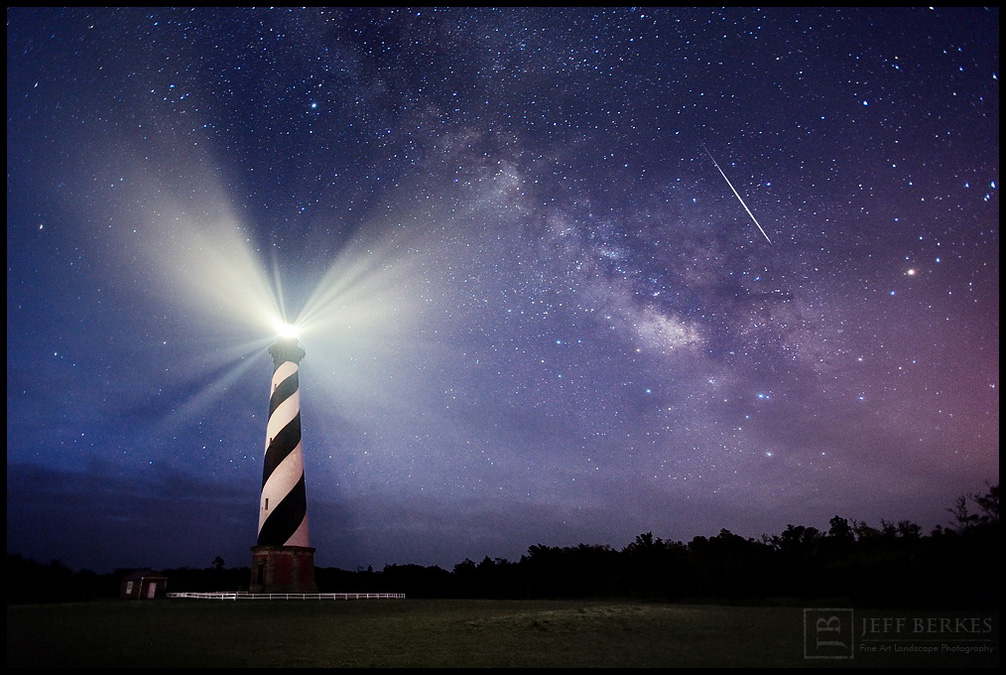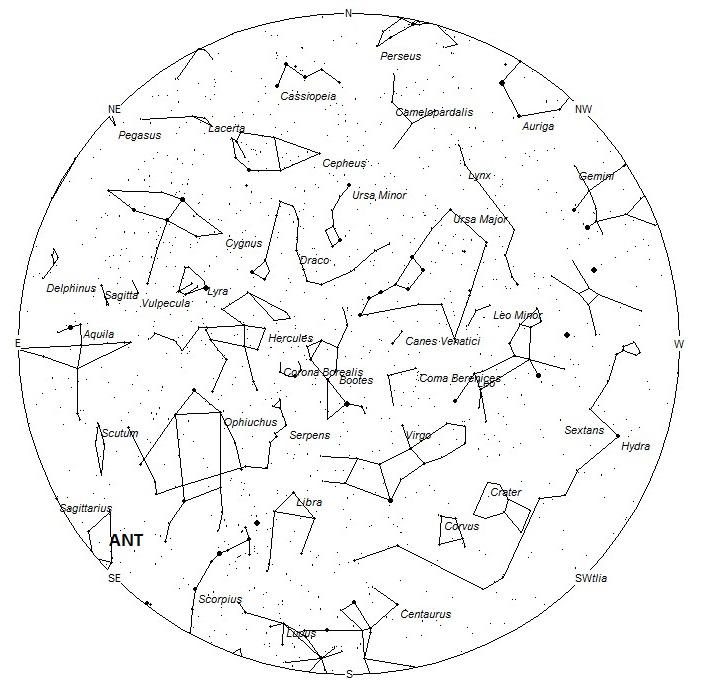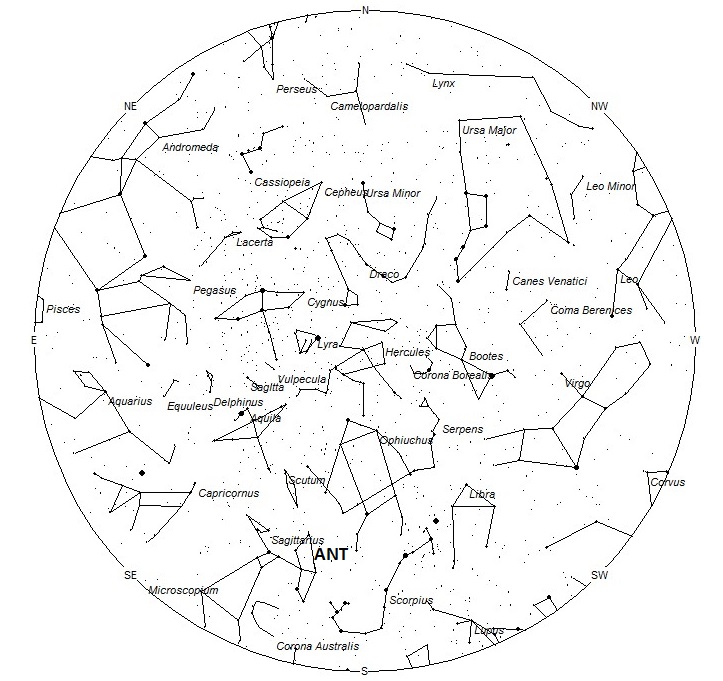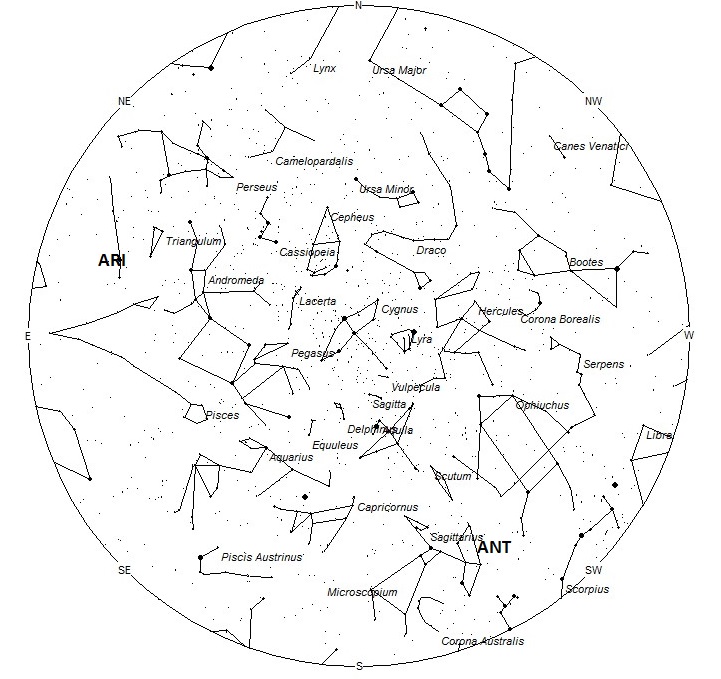
Cape Hatteras Lighthouse, the Milky Way and a Lyrid Meteor, 2013 © Jeff Berkes
During this period the moon reaches its last quarter phase on Tuesday June 9th. At this time the moon will be located 90 degrees west the sun and will rise near 0100 local daylight saving time (LDT) as seen from mid-northern latitudes. This upcoming weekend the waning gibbous moon will rise during the late evening hours and will compromise meteor observing the remainder of the night due to its intense glare. As the week progresses conditions will improve as moon rise occurs later in the morning and the moon’s phase wanes producing less light. The estimated total hourly meteor rates for evening observers this week is near 2 for observers situated at mid-northern latitudes and 3 for observers viewing from the southern tropics (latitude 25 S.). For morning observers the estimated total hourly rates should be near 7 for observers situated at mid-northern latitudes and 10 for observers viewing from the southern tropics. The actual rates will also depend on factors such as personal light and motion perception, local weather conditions, alertness and experience in watching meteor activity. Morning rates are reduced during this period due to moonlight. Note that the hourly rates listed below are estimates as viewed from dark sky sites away from urban light sources. Observers viewing from urban areas will see less activity as only the brightest meteors will be visible from such locations.
The radiant (the area of the sky where meteors appear to shoot from) positions and rates listed below are exact for Saturday night/Sunday morning June 6/7 These positions do not change greatly day to day so the listed coordinates may be used during this entire period. Most star atlases (available at science stores and planetariums) will provide maps with grid lines of the celestial coordinates so that you may find out exactly where these positions are located in the sky. A planisphere or computer planetarium program is also useful in showing the sky at any time of night on any date of the year. Activity from each radiant is best seen when it is positioned highest in the sky, either due north or south along the meridian, depending on your latitude. It must be remembered that meteor activity is rarely seen at the radiant position. Rather they shoot outwards from the radiant so it is best to center your field of view so that the radiant lies at the edge and not the center. Viewing there will allow you to easily trace the path of each meteor back to the radiant (if it is a shower member) or in another direction if it is a sporadic. Meteor activity is not seen from radiants that are located below the horizon. The positions below are listed in a west to east manner in order of right ascension (celestial longitude). The positions listed first are located further west therefore are accessible earlier in the night while those listed further down the list rise later in the night.
These sources of meteoric activity are expected to be active this week.
The center of the large Anthelion (ANT) radiant is currently located at 17:56 (269) -23. This position lies in western Sagittarius, 8 degrees northwest of the 3rd magnitude star known as Alnasl (Gamma Sagittarii). Due to the large size of this radiant, Anthelion activity may also appear from eastern Scorpius, southern Serpens Cauda, and Scutum as well as Sagittarius. This radiant is best placed near 0100 Local Daylight Time (LDT), when it lies on the meridian and is located highest in the sky. Rates at this time should be near 2 per hour as seen from the northern hemisphere and 3 per hour as seen from south of the equator. With an entry velocity of 30 km/sec., the average Anthelion meteor would be of slow velocity.
The radiant for the Daytime Arietids (ARI) only lies 45 degrees west of the sun. Therefore these meteors can only be seen between the time the radiant rises and dawn. This is a small window of opportunity that lasts for about an hour before the break of dawn. The exact position of the radiant is 02:10 (044) +24. This position lies in western Aries, close to the position occupied by the 2nd magnitude star known as Hamal (Alpha Arietis). Despite being a strong source of meteors, visual members of this shower are rare due to the low altitude of the radiant. If this radiant was better placed in the sky it would rival the better known Perseids of August. These meteors are the strongest source of radio meteors for the entire year. With an entry velocity of 42 km/sec., the average Daytime Arietid meteor would be of medium speed.
As seen from the mid-northern hemisphere (45N) one would expect to see approximately 5 sporadic meteors per hour during the last hour before dawn as seen from rural observing sites. Evening rates would be near 2 per hour. As seen from the tropical southern latitudes (25S), morning rates would be near 8 per hour as seen from rural observing sites and 3 per hour during the evening hours. Locations between these two extremes would see activity between the listed figures.
The list below offers the information from above in a condensed form. Rates and positions are exact for Saturday night/Sunday morning.
| SHOWER | DATE OF MAXIMUM ACTIVITY | CELESTIAL POSITION | ENTRY VELOCITY | CULMINATION | HOURLY RATE | CLASS |
| RA (RA in Deg.) DEC | Km/Sec | Local Daylight Saving Time | North-South | |||
| Anthelions (ANT) | – | 17:56 (269) -23 | 30 | 01:00 | 2 – 3 | II |
| Daytime Arietids (ARI) | Jun 07 | 02:10 (044) +24 | 42 | 10:00 | 1 – <1 | II |
 American Meteor Society
American Meteor Society



We just saw three fireballs in the sky above Johnstown, Pennsylvania. There were awesome!!
We saw a ball of fire coming down from the sky Saturday night (6/6/2015) at about 10:30pm.. we are in the southernmost tip of Texas in Brownsville
Saw a fireball this evening (June 11, 2015) that split in two before blinking out. Very bright … quite amazing. The time was about 9:00pm and the location was central Texas.
I saw a huge ball of fire (meteorite)? about 3 weeks ago (around the first week of June 2015) fall from the sky. I have never seen anything like it in my life. (57 years). It was absolutely amazing. I’ve seen many falling stars but never anything like that. If I point my compass in that direction it reads 90 degrees E. But I’d say it was coming from the direction of the north and heading in the direction of the south, towards the ocean. The time was somewhere between 10:00 pm and midnight. I don’t know if this is important or not but My coordinates read 49 degrees 28′ 59″ N and 123 degrees 46′ 10″ W, 40 m Elevation. I live on the Sunshine Coast, British Columbia.
Please, feel free to fill a report here: http://www.amsmeteors.org/members/imo/report_intro